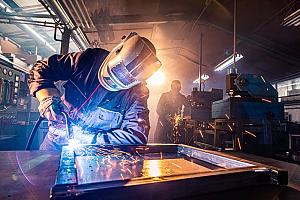Editor
- FMA
- The Fabricator
- FABTECH
- Canadian Metalworking
Categories
- Additive Manufacturing
- Aluminum Welding
- Arc Welding
- Assembly and Joining
- Automation and Robotics
- Bending and Forming
- Consumables
- Cutting and Weld Prep
- Electric Vehicles
- En Español
- Finishing
- Hydroforming
- Laser Cutting
- Laser Welding
- Machining
- Manufacturing Software
- Materials Handling
- Metals/Materials
- Oxyfuel Cutting
- Plasma Cutting
- Power Tools
- Punching and Other Holemaking
- Roll Forming
- Safety
- Sawing
- Shearing
- Shop Management
- Testing and Measuring
- Tube and Pipe Fabrication
- Tube and Pipe Production
- Waterjet Cutting
Industry Directory
Webcasts
Podcasts
FAB 40
Advertise
Subscribe
Account Login
Search
Manual? Automatic? Press brakes can bend with job demands
Millomat Stampings uses robotic brake to mitigate labor shortage, improve quality
- By Lincoln Brunner
- June 3, 2024
- Article
- Bending and Forming

The SafanDarley R-Brake operating nearly nonstop at Millomat Stampings can handle all facets of press brake bending automatically, from picking up the blank to placing the finished part on a pallet. Images: SafanDarley
No one has to tell Mani Sehmbi how to deal with adversity, roll with the punches, or get with the times.
He’s been doing that his entire adult life.
When Sehmbi was just 18, his father, Jaswinder—founder of the family business, Millomat Stampings in Mississauga, Ont.—suffered a brain hemorrhage. Sehmbi, who already had been learning the ropes at the shop for a couple of years, suddenly found himself dropping out of school and running the 120-person operation because no one else could.
Customers soon found out, though, and lost faith. Many pulled their business, dropping annual company revenue from about $6 million down to $2 million. But rather than close the doors and bemoan his fate, Sehmbi decided to change course completely and focus on metal fabrication instead.
Now 38, he is CEO of the company, which specializes in sheet metal fabrication for the food service equipment and construction industries while using robotics and automation to keep its competitive edge.
The Big Shift
That turnaround happened in stages, of course. Today, the company still offers tool and die work, as well as a bevy of other services including tube fabrication, welding, and polishing and grinding. But its main driver, and Sehmbi’s focus since that day 20 years ago, is and will be sheet metal fabrication.
Millomat Stampings’ facility houses several laser cutting machines and other key capital investments—namely its lineup of four SafanDarley press brakes, which feature a level of robotic automation that quickly changed the way its operators thought about fabrication.
But it didn’t start out that way. The machine’s slim design deceived Sehmbi, who’d been working with press brakes for years but had not seen one like this. He especially wasn’t sure that the results were going to justify the sizable investment.
“When I saw it for the first time … I didn’t like it,” Sehmbi said. “I’m like, ‘It’s so lightly built.’ It didn’t look like it would do the job.”
It did the job, and Sehmbi’s perspective turned 180 degrees the moment Millomat’s first 100-ton SafanDarley press brake was installed in 2016.

AutoPOL software allows programmers to see parts in all stages of fabrication before they’re bent on the press brake.
“We put the machine in the shop, and it literally shut down two of my other machines, right away, off the bat—I would say second day on the machine,” Sehmbi recalled. “Now, everybody was spoiled on it.”
Operators chose to wait for the new brake instead of getting to work on the other machines. “I was like, ‘Guys, why aren’t we starting these jobs?’” Sehmbi said.
The answer was that they could have used the shop’s other press brakes, but by the time the workers put them on those other machines and ran four or five parts that were going to be scrap anyway, they could have just put them on the Safan and run good parts from the first try.
It took all of two years running that first SafanDarley brake 24/7 to justify a second, and just one more year to justify a third.
The fourth, a fully automated R-Brake 130T, can load tooling as well as scan, pick up, reposition, bend, pack, and stack parts autonomously. It also can readily switch over to manual mode for smaller jobs like prototyping because the robot attached to it can be moved aside rather than permanently parked in front of the unit like most other bending cells.
“We’ve had a unique kind of approach where we said, ‘No, let’s put a robot on a machine but make that robot [moveable], off to the side,’” said SafanDarley Vice President of Sales Kyle Zellmann. “The machine is still fully usable as a manual machine. Then at night when you leave, you close the gates, you put material in it, and it runs as a robotic cell.”
That feature can make the R-Brake more attractive to shops like Millomat that often move between part runs in the thousands and smaller batches. Millomat routinely bends longer runs, short batches, and prototypes on the same machine, Sehmbi said.
In fact, Millomat operators have learned the machine so well and come to depend on it so much, sometimes they won’t bother moving the robot at all, even for onesie-twosie stuff. To Sehmbi, it illustrates the versatility of the machine, but also the ease of use of the system’s AutoPOL control software.
“We’re actually so lazy,” Sehmbi said facetiously. “If we have to do a prototype, we’ll quickly blast it off on the robot—a couple of pieces, two or three, depending on if the other machines are busy. We’ll use AutoPOL to put the tooling into the machine. We’ll get the robot to put the tooling in because it only takes three or four minutes, max. It’s pretty fast. Guys will go in [and] just bend five or six prototypes.
“By the time the people are done loading the machine up, we’ll hit ‘quit’ and then go back on the workload manager, and that will say we have the wrong tooling in. It’ll automatically take out the tooling that we used for prototyping, put the tooling back for the job that’s going to be running, and then go run.”
Easy Control, Easy Training
Sehmbi credited the machines’ control system with getting new people acclimated quickly. (He alluded to the three young women basically running Millomat’s machinery). And while Sehmbi noted that some people in certain online communities remain skeptical of the belt-and-pulley system within the Safan all-electric benders, one thing they cannot talk any trash about is the control system.
“The best part is that … the control is very user-friendly,” Sehmbi said. “I have three full-time programmers. They’re running the machines. I have [one] running my R-Brake. She’s actually programming and running the brake, calling up programs, checking the tools, cleaning the machines, and doing maintenance on them. These machines are really easy to use.”
Zellmann said that the SafanDarley controls were designed to address the one burning question the company gets over and over.
“I think the biggest conversation is about, ’How quickly can I program a part? That’s number one because I’ve got a high mix, a lot of low lot sizes,’” Zellmann said. “That’s the first question we try to address: What does it look like to program a part and get it in the cell? We want to provide a complete solution from model to unbent part to robot program and press brake program.
“We look at it from a standpoint that a lot of customers want to be ready for automation.”
And while Sehmbi has 92 employees, among them many who can run the brakes proficiently, many customers are fighting the labor shortage battle like never before. That’s the impetus behind control software that can do what these brakes’ controls can do—helping shops that can’t find people turn out parts regardless.
“Before COVID, what would happen when you saw people in here [SafanDarley’s office in Wisconsin], they would ask, ‘What’s the minimum number of parts I need to run in a robot cell? Can you make it go any faster? What does it take to program?’ You know—all those types of questions,” Zellmann said. “Now, it really has become like, ‘I don’t care if I’ve got to bend 10 parts with a robotic cell, because that’s the only way I’m going to get a bend. I don’t have an operator. I can’t get operators in front of press brakes.’ So those questions about speed and about how quickly I can bend a batch of parts really have gone out the window.
“[Now] it really is, ‘What type of person do I need to hire to program a robotic press brake? Can I just have material handling people manage that cell once I have my laser off?’ On the robotic press brake, the answer is yes, because they basically become material handling people. You can get enough material in there where your laser guy can now run a robotic press brake as well because all he’s doing is feeding in material.”
Sehmbi laments the proficiency level of people he sees working in manufacturing. To him, that makes having equipment that can deliver good parts with minimal stress a must.
“There’s not very bright people out in the industry,” Sehmbi said flatly. “With the minimal training we provide, we can get somebody onto those machines up and running and producing quality parts, accurate parts, in very little time.
“We pretty much have this thing down pat,” he said. “My guys—you know when your parents … used to get nervous from the stuff you did? I used to do that, and now my guys on the floor are really utilizing the robot a lot, like 99.9% of the time. Sometimes I get scared down there, and I’ll be like, ‘I don’t agree with that movement there.’ And the guys are like, ‘Boss, we already bent 500 parts and we haven’t had one issue.’ They have me on my edge, which is good.”
About the Author

Lincoln Brunner
2135 Point Blvd.
Elgin, IL 60123
(815)-227-8243
Lincoln Brunner is editor of The Tube and Pipe Journal. This is his second stint at TPJ, where he served as an editor for two years before helping launch thefabricator.com as FMA's first web content manager. After that very rewarding experience, he worked for 17 years as an international journalist and communications director in the nonprofit sector. He is a published author and has written extensively about all facets of the metal fabrication industry.
Related Companies
subscribe now

The Fabricator is North America's leading magazine for the metal forming and fabricating industry. The magazine delivers the news, technical articles, and case histories that enable fabricators to do their jobs more efficiently. The Fabricator has served the industry since 1970.
start your free subscription- Stay connected from anywhere

Easily access valuable industry resources now with full access to the digital edition of The Fabricator.

Easily access valuable industry resources now with full access to the digital edition of The Welder.

Easily access valuable industry resources now with full access to the digital edition of The Tube and Pipe Journal.
- Podcasting
- Podcast:
- The Fabricator Podcast
- Published:
- 07/02/2024
- Running Time:
- 66:34
Desirée Guzmán, a welding instructor with Chicago Women in Trades (CWIT), joins us to talk about her full-circle...
- Industry Events
Precision Press Brake Certificate Course
- July 31 - August 1, 2024
- Elgin,
Laser Welding Certificate Course
- August 6 - 8, 2024
- Farmington Hills, IL
Golf 4 Manufacturing
- August 19, 2024
- Waukegan,
The Fabricator's Technology Summit
- August 20 - 21, 2024
- Eglin, IL































